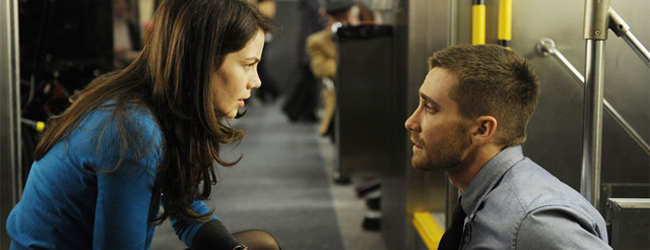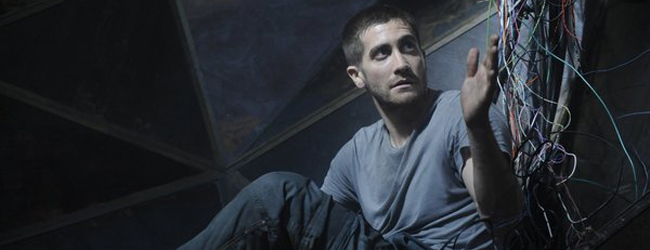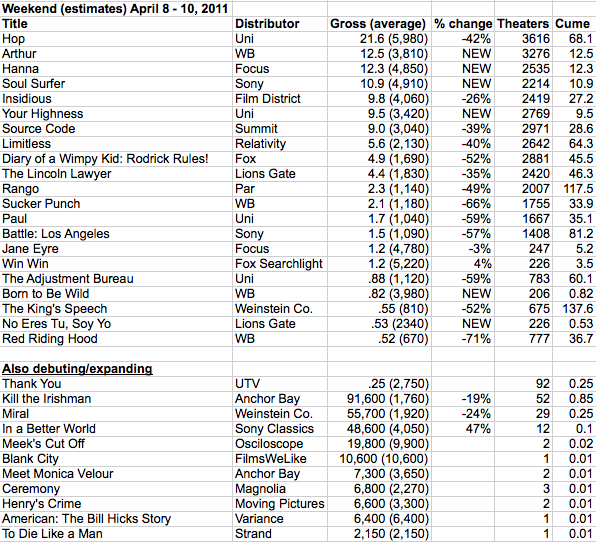“Source Code” (Four Stars)
U.S.: Duncan Jones, 2011

“Those who cannot remember the past are condemned to repeat it”
— George Santayana
“Time is on my side.”
— The Rolling Stones
1. We’re on a commuter train, racing toward Chicago. Something is wrong. It’s a nightmare.
We’re also at the start of the first eight minutes of Source Code, a spellbinding science fiction thriller — from director Duncan Jones and writer Ben Ripley — about a hellbound train and a man (Who is he? Where is he?) who keeps reliving the last eight minutes of another man‘s life in order to find a terrorist bomber and save a city from flaming death.
Now, a friendly warning: No SPOILER ALERTS here because THE WHOLE REVIEW IS A SPOILER, and so is every other review of this movie, including the ones you’ve probably already read, and the few lines I‘ve already written here.
My advice: Walk in cold. You won’t, but you should. This is the best, most exciting, smartest, most amusingly inventive, and most thoroughly entertaining science fiction movie I’ve seen since Inception. And you’ll like it better if you start the ride with very little baggage, just like the hero/protagonist, Captain Colter Stevens (played spotlessly by Jake Gyllenhaal) –a bit confused, bewildered, not knowing what’s going on, and trying falteringly to grab your bearings on something like a speeding train heading toward Chicago. But first, you’ve got to figure out who you are. Stevens (Gyllenhaal)? Or somebody named Sean Fentress (Federick De Grandpre)?
Okay.
Stop.
Don’t blame me if you didn‘t. Anyway, we’ll try to leave you enough surprises, the ones that count.
2. So we’re back with Captain Stevens, an Army pilot who, the last thing he knew, was flying a helicopter in Afghanistan. Now he‘s waking up after a supposed snooze on his seat on the Chicago Commuter Line, a fictionalized, somewhat idealized version of Metra Rail, and staring at him is someone who acts like a friend, but whom he doesn’t know, but who calls him “Sean“ (whom he doesn’t know either): a very sexy lady named Christina Warren (played by the very sexy Michelle Monaghan), with a curious catlike grin that’s both warmly inviting and sometimes strangely spooky.

The conductor takes his ticket (Stevens doesn’t know where it is, and Christina, who does, grabs it out of his pocket). A passing lady spills coffee on him. He goes to the bathroom to clean up and looks in the mirror and the face he sees isn’t his. It’s maybe Sean’s (De Grandpre’s), though the man looking into the mirror is still Stevens (Gyllenhaal). Stunned and a little scared, he walks back to his seat and Christina, to try to figure out what the hell is going on, and then the train explodes .
Now, there’s an opening for a movie thriller! Sucker Punch, eat your heart out. It’s science-fiction. It’s adventure. It’ mystery. It’s noir. It’s Strangers on a Train, and Unstoppable and Runaway Train. It’s The Bourne Identity. It’s The Twilight Zone. And, as critic after critic has noted, it will soon morph right into Groundhog Day. (This movie is something else as well: it’s the film descendant of a great story that beat Groundhog Day to the punch by almost forty years. I’ll tell you more about that later.)
Jones and Ripley and all their actors and technicians seem in perfect sync in that scene. And because of that, we know we’re in good hands, that we‘ll want to stay on that ride all the way to the end of the line. Again.
3. That first scene was our first eight minutes. Now Stevens wakes up and he‘s in something that looks like a dark simulated training cockpit, or some kind of weird dark cell, and on the video is the cold, expressionless face (Christina always smiles; this woman doesn’t) of a strictly-business uniformed Army officer named Colleen Goodwin (the always-damned-good Vera Farmiga) who’s his contact. She starts to explain the seemingly inexplicable to him — while her limping, impatient, unlikably authoritarian boss, Dr. Rutledge (the always-damned-good Jeffrey Wright) occasionally looms behind her.

She tells him: There is no train, not any more. It blew up in the bomb explosion and everybody died, including both Christina and Sean.
What exactly happened to Stevens in Afghanistan she doesn’t explain. But the consciousness that was once Stevens, is now being shuttled, thanks to a top secret Army software program called “Source Code,“ into and out of a body and the consciousness — still imprinted somehow, somewhere — of the last eight minutes of Sean’s life before the explosion. How it was preserved, we don’t know. How the program, Source Code, really works, we don’t know either.
We know very little, in fact, and only what Stevens himself learns: that he’s going to be sent back to that train to do a job, and he has exactly eight minutes and no more each time he’s sent back, and that it’s always the same eight minutes for everybody else, but not for him.
Now though, he’ll remember everything that just happened, in or out of the train’s “reality,” from the time he woke up and saw Christina. He’ll also know that he’s supposed to use his time to find the bomb, and find the killer (who was on the train before it blew), so that the Army and the police can stop that same murderer/terrorist from using another, bigger bomb later that day in Chicago.
We have to take a lot of all this on faith. Yet, if we do accept it, and go with it, we’ll like what we see.
But will Stevens? Time and again, in Source Code, he keeps going back, keeps reliving those same eight minutes, seeing once again that warm, spooky smile, seeing that diverse, colorful, seemingly ordinary bunch of passengers and train workers — an angry guy who’s a standup comic (Russell Peters), a seeming businessman (Cas Anvar), a college kid (Kyle Gatehouse), the lady with the coffee cup (Paula Jean Hixson), a guy with a soda can (Albert Kwan), a seeming snob with intense eyes (Michael Arden), another businessman with a gold watch (Craig Thomas), the fatherly conductor (Gordon Masten), or maybe even Christina herself — and wondering which of them, or of all the others aboard, is the killer.
Or perhaps it’s all a ruse and a snare. Maybe Stevens will learn in the end that somebody in Source Code is lying, filling him with false memories, using him for another plot, something maybe even worse.
Whatever the explanation, something else starts happening in those repeated strands of time and those possible realities. Stevens, a smart soldier, is piecing together the puzzle, learning more and more each time. But he‘s also getting more drawn to Christina and more hooked on her warming, almost constant smile. He wants to save her. But he seemingly can’t. He wants to keep the train from exploding. But he seemingly won’t. He wants to be alive as himself again, in something more than a dark cell with a video screen and the unsmiling Goodwin. He wants to live his own life and not eight minute chunks of another man‘s tragic finale. But…

4. Some reviewers who don’t like Source Code, and even part of the vast majority who do, think that the movie just doesn’t make sense. Well, yeah. Of course it doesn’t make sense. Neither does a magic carpet, or a genie with his three wishes, or the Man With No Name gunning down a barroom gang, or Orpheus descending into hell to bring back Eurydice. You want sense, take the Metra Rail.
In our “real” life though, you obviously can’t keep going back in time and reliving eight minutes of another man‘s life, a man who may have been physically destroyed in the bomb blast. Even if you could, there are all kinds of problems of parallel worlds and about what people do in the reconfigured time (including people who first stayed on the train on the last stop before the blast, but left during other trips), and about a glitch in the bomb detonation (two trains have to pass each other), and about maybe altering the future and creating many different alternate futures, like strands of life inter-twisted — all stuff that Source Code just doesn’t go into much. Maybe the filmmakers or their publicists should have put footnotes and an appendix in the press notes, instead of that dinky little synopsis they gave us.
One of the main plot gimmicks in many time travel stories — from Ray Bradbury‘s The Sound of Thunder to Robert Heinlein’s By His Bootstraps and All You Zombies, all the way up from H. G. Wells’ The Time Machine to the recent movie of Audrey Niffenegger‘s The Time Traveler‘s Wife — is the problem of paradoxes, of whether or not the things a time voyager does when he goes back into the past can ultimately alter his/her or everyone‘s future. Step on a blade of grass, kill a bug and the world changes. Maybe you’ll decimate a whole species.
But it doesn’t matter. It’s a pointless complaint because though you may someday be able to travel into the future, by something involving suspended animation or the speed of light, we’ll never, never go back into the past. Trust me.
Screenwriter Ripley gets to create his own rules because it’s his own world: his and Jones’s, and their fellow filmmakers. They set the rules, not Newton or Einstein.
5. Now I’ll tell you about the story I mentioned: the one that used the repeated time plot device a long time before Groundhog Day. It’s an old science fiction story that may even have inspired Harold Ramis. (Ramis looks to me like an ex-kid science fiction fan.) It was published almost 40 years before , in the mid-‘50s, in editor H. L. Gold’s magazine, “Galaxy Science Fiction.” It was called The Tunnel Under the World, and it was written by the famous science fiction writer and editor Frederik Pohl, who was one of Philip K. Dick‘s most sympathetic editors, one of Isaac Asimov’s oldest friends, and also co-author (with C. M. Kornbluth) of the classic novel satire of advertising The Space Merchants (a.k.a. Gravy Planet), and who, the last I heard, lives in Palatine. Il. — within reach of Chicago, by commuter train.
Pohl’s fantastic story was about a man named Guy who wakes up screaming out of a dream every morning, except one day when he falls asleep not in his bedroom, and he discovers when he wakes up the next morning that it’s the same day all over again. That night Guy deliberately hides and he discovers the next day that each new morning is always the same date, (just like Bill Murray would learn in Groundhog Day four decades later). Only a few others in the town know this, including a pretty woman who, like him, hides each night so she won’t wake up and not know it’s the same day, even though now, remembering and repeating, she feels like she’s going crazy.
The Tunnel Under the World is a terrifying story, and it’s also a pointed political satire about consumerism and conformity. I won’t tell you what else happens, because you might want to read it some day. But, years before Groundhog Day came out in 1993, I always thought Pohl’s “Tunnel” would make a great movie. Terry Gilliam (“Brazil”) could have directed it. (It’s too late now. People would say the Pohl movie was ripping off Groundhog Day.)
As far as I remember, the only things in “Tunnel” repeated in either Groundhog Day or Source Code are the idea of the repeated time replaying over and over, the day or the eight minute chunk, and the fact that each story has a pretty girl, waiting, in that niche of time. But it’s still a powerful premise, an ultimate nightmare, a classic from the heyday of science fiction geniuses like Dick, Asimov, Bradbury, Pohl, Heinlein, Theodore Sturgeon, Arthur C. Clarke, and Alfred Bester. Somebody should really mention that story, and Pohl, and “Galaxy Science Fiction,” in reviews of Source Code, and not just keep repeating the mantra “Groundhog Day” over and over — even though Ramis and Murray made something terrific out of the notion too.

Source Code, like Tunnel Under the World, is less a prediction or extrapolation than a nightmare, and it lives and dreams by the logic of nightmares. That’s why the comparisons between Source Code and The Twilight Zone — and the many, many comparisons being made to Philip K. Dick’s stories — are apt. These references summon up science fiction tales not about explorations of outer space (which, at least outside our solar system, seems not as inevitable as we once thought), but about exploring inner space: a dimension, as Rod Serling was wont to say, “not of time or of space, but of mind.“
Almost every nightmarish story Serling, or his guys Charles Beaumont and Richard Matheson dreamed up for the “Zone“ can be explained very simply. (And so can some of the ones on the Zone-inspired The Outer Limits.) The main character, whom Serling usually identifies with, could be really crazy. He or she is not really traveling back or forward in time, or being pursued by menaces and phantasms, or going through the same murder trial again and again, or suddenly gaining strange powers, or being a librarian left with lots of books and no glasses, or seeing a monster out on the wing of the plane 20,000 feet up. In our terms, the only ones we usually live by, they’re all insane. Demented. Seeing things. Or having nightmares and not yet awake.
Serling though, in these “Zone” teleplays, chooses to present this craziness as something actual. He imagines what it would be like if the nightmares become real, if there were monsters, if there were strange powers, if there were time travelers. (He also used “Zone” to talk about nightmares that were only too possible, like the threats of totalitarianism, bigotry or the Bomb.)
Conversely, for the menaced and driven characters in Philip K. Dick’s stories, and all the alternative realities they keep finding or living in, insanity is only one of several explanations. For Dick, it’s the worlds they live in (and that he lived in) that were often crazy. But it’s often there, a teasing hint. — even in his scathing but compassionate look at drug addicts, based on people he knew, in the realistic, semi-autobiographical “A Scanner Darkly.”

6. That’s what happens in Source Code. We’re seeing a nightmare, laced with the logic of a nightmare, while the filmmakers keep asking us: What if it were real? You should read Rog Phillips’ story “The Yellow Pill” sometime, to find out how terrible a question that can be.
Phillips’ story, published in the magazine “If,“ which Pohl later edited and for which Dick frequently wrote, is one of the great science fiction stories, though Phillips, who died at 55, only a few years after writing it, seems almost forgotten today. (He also wrote another great heart-breaking story, called “Rat in the Skull.“) “The Yellow Pill” is about a psychiatrist treating a man, a homicidal maniac, who’s gone crazy and thinks he’s an astronaut aboard a space ship, and that the psychiatrist is one too, and that the innocent people he killed were really deadly space aliens.
The maniac, even as he raves on like this, seems strangely sure of himself, with a manner amazingly self-possessed and apparently totally rational. Since the psychiatrist can’t reason with him or crack his façade of normality, he suggests that the maniac take a “yellow pill,” a drug that destroys psychosis and dementia, and induces a true perception of reality. The man agrees, but only if the doctor will take it as well. And the doctor concurs.
At their regular meeting, they both take the yellow pill that wipes out insanity and delusions, that puts you in the real world. And it works, of course. Twice. The maniac, contrite, sees that he was wrong, that he really is just a man, albeit a murderer, living not out in space, but on earth, and he apologizes and walks to the door to open it and leave the doctor’s office. The doctor, meanwhile, who can’t stop him, has realized that he is actually an astronaut aboard a space ship and that, while he remains powerless to stop him, his friend and crewmate has just opened a space lock and is calmly stepping outside to his death.
“The Yellow Pill” was an ideal Twilight Zone-style story, and it almost certainly would have made one of their all-time classic shows, and probably a great showcase for a director like John Brahm (“Time Enough at Last“). Sadly, Serling and his guys never used it, maybe didn‘t know about it. It was adapted instead on two other much lesser-known TV shows: “Out of This World” (which starred Boris Karloff) and “Out of the Unknown.” Today, those rare programs, relics with a mention on imdb, may have vanished.
The best of these “real” nightmares — and Source Code is one of the most powerful of recent movie nightmares, far scarier and more engrossing than trendy bloodbaths and massacres such as the latest Saw or Battle: Los Angeles — are stories that sometimes have something beautiful in them as well: a poetry of solitude and alienation. That melancholy, almost Antonionian feeling is also part of Jones‘s first (and only other) feature, the science fiction thriller-drama Moon, with Sam Rockwell and Kevin Spacey as two astronauts (with one other) on a moon base — a situation very like “The Yellow Pill” and also like Andrei Tarkovsky‘s eerie film masterpiece based on Stanislaw Lem’s novel Solaris).
Moon has been prized by some critics above Source Code; I don’t think it’s as good. But both films are the work of a rare talent. Both Jones’ films use a popular s. f. thriller form to explore something deep and troubling in our common psyche: the riddle of identity in the case of Moon, and the seeming impossibility of avoiding destiny or death, or of saving loved ones, in Source Code.
Can you grab or grasp time, cheat death? Can you slip its embrace? And if you try and fail, will it matter? Yes, of course it will, the movie affirms, which is one of the reasons I like it.
In fact, it always matters, even if all your love is in vain, and there’s only another explosion or massacre waiting at the last tick of the clock.

7. It’s a minor point, but I don’t like the title Source Code, which remains something of a cipher even after you see the movie. But maybe you just can’t use the obvious, much better title, “Eight Minutes,” because there’s already been a lousy Al Pacino thriller called 88 Minutes and a John Avildsen rodeo picture called 8 Seconds. And there’s an 8 Women, by Francois Ozon, with Catherine Deneuve, and an Eight Men Out (John Sayles on the Chicago Black Sox scandal), an 8 Mile (Eminem, rap), an 8MM (Nic Cage, snuff porn), a Hard Eight (Paul Thomas Anderson on gambling), and 8 Million Ways to Die (an L. A. neo-noir by Hal Ashby, Oliver Stone, Bob Towne and Andy Garcia). And, of course the greatest “Eight“ film of them all: Fellini’s 8 ½ (Ciao, Federico!)
Since we’ve been talking so much about Rod Serling, let’s also remember that his ace liberal ‘50s teleplaywright compatriot, Reginald Rose, made Juror Number Eight the humanitarian hero of his classic courtroom drama Twelve Angry Men. (Henry Fonda, of course. And anyone for cards and Crazy Eights and aces and eights — the dead man‘s hand? I told you it was a minor point.)
Well, that’s about all I have to say on Source Code. (I still prefer “8 Minutes,“ by the way.) Except this: The director, the writer, the actors, the artist/technicians (cinematographer Don Burgess of Forrest Gump, production designer Barry Chusid of 2012, editor Paul Hirsch of Carrie) who worked with them on this movie are all probably as good as Ripley and Jones (David Bowie’s son, by the way) could want: each of them contributing strongly to a seamless whole.
I maybe would have preferred a different, darker ending than the one Ripley and Jones use — but maybe not.

8. Okay. We’re done. We stop at the end of the next paragraph. But think it over — not just about whether you want to see the movie, or if it’ll make money, or if you want to curse me out for writing such long, repetitive, self-indulgent reviews, but about whether Freud was right or Rod Serling was right — about nightmares, about what they mean, and about how real they can be.
You’ve got eight minutes.














